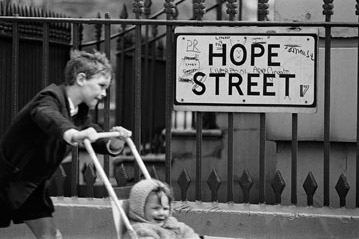
| HOME |
| NERVE |
| REVIEWS |
| ARCHIVE |
| EVENTS |
| LINKS |
| ABOUT US |
| CONTRIBUTORS |
| BACK ISSUES |
| CONTACT US |
 Recollections
Recollections
Phillip Jones Griffiths
National Conservation
Museum
17th October 2008 – 15th March 2009
Reviewed by Anthony Swords
Beginning an illustrious career with The Manchester Guardian and then The Observer in the 1960s, Phillip Jones Griffiths covered some of the most defining events of the last forty years.
The display of selected works at the National Conservation Museum exhibit a photographer keen to reveal the ordinary people who lived through the strange and rapidly changing conditions of this era as shown in the surreal Northern Ireland, 1973. Here Griffiths captures a woman, adorned in domestic attire going mowing her lawn while a British soldier, rifle in hand, crouches behind her garden fence.
Liverpool was not a place neglected by Griffiths even after he moved down to London. His photos from the sixties perfectly capture a place of extreme contradictions, as an era that has become crystallised in myth through the decades. Next to his intimate portraits of The Beatles, with all the glamour and excitement they conjure, are many taken in Liverpool’s inner city and backstreets. Compared to the ideas of the age of rock ‘n’ roll and swinging London that this era triggers, the city looks more like Victorian England, complete with mucky faced street urchins. Griffiths’ attention to detail, however, gives these pictures a more resonant feeling than those concerned with pop culture as the graffiti of the day still looks oddly contemporary.
It is a pity that the works from his days in Vietnam are not shown in their original state but the museum has installed a screen to show them in still video format. Even so they are truly moving works that convey his mastery of light and composition. More than this, Griffiths still manages to dedicate his work to the people caught in the conflict on both sides and not focus on the machinery and scale of war. Despite the horror and tragedy on display, Griffiths reveals the humanity of those in the crossfire as well as the beauty of his medium.
Much of the work is also accompanied by some of Griffith’s own comments, which are just as insightful and interesting as the photos on display. The exhibition is not only a great record of 20th century life but also a wonderful example of photographer as artist and commentator.